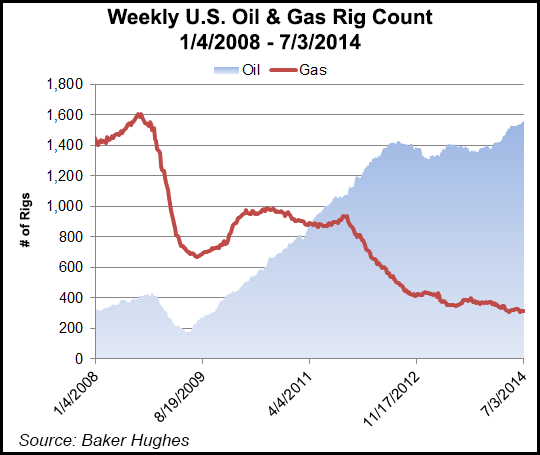NGI Archives | NGI All News Access
Newbuild Surplus Puts Pressure on U.S. Offshore Drillers
The supply of vessels for U.S. offshore drilling has led to a surplus following several years of new construction, which in turn has cut into the dayrates, but healthy commodity prices should keep the credit profiles stable for at least another year, according to a report by Standard & Poor’s Ratings Services (S&P).

Primary credit analyst Marc D. Bromberg oversaw the report issued on Monday, “New Onshore Dynamics Test U.S. Onshore and Offshore Drilling Contractors.”
“Following several years of robust spending on new vessels, drillers are confronting excess supply relative to demand in the deepwater market in 2014,” Bromberg said. “As a result, dayrates for the most sophisticated ultra-deepwater drillships have fallen closer to the $500,000 level, from a peak last year typically above $600,000.”
“Rates for jack-up rigs have been more resilient, but additional supply during the course of 2014 and 2015 could pressure rates.”
S&P analysts are forecasting capacity to remain high relative to demand, particularly for deepwater and ultra-deepwater vessels, “at least through 2015 and possibly through 2016,” said Bromberg.
Based on IHS Inc. projections at the end of 2013, Bromberg expects the ultra-deepwater supply to increase by 23 vessels in 2015 and by 28 in 2016.
“Demand is unlikely to grow sufficiently in the near-term to offset this rapid growth, in our view. However, over the longer term, possibly starting at the end of 2016 or in early 2017, our current expectation is that a slowdown in new construction should allow for better balance in the floater market.”
S&P analysts said several factors should support deepwater and ultra-deepwater demand over the long-term, including healthy oil prices and rising demand from Mexico’s Petroleos Mexicanos following extensive energy reforms.
“Our outlook for offshore drillers remains mostly stable, due to our view that additional vessels will not significantly erode most operators’ credit protection measures,” Bromberg said. “And although we expect downward pressure on dayrates for at least the next 12-18 months, many operators have multiyear contracts in place for a large proportion of their floaters, which tempers this risk. Moreover, additional cash flows and earnings from new vessels entering the marketplace should help to mitigate a downturn in dayrates.
“However, if we believe a downturn is likely to persist well past 2016, this could influence our outlook for recontracting risk and profitability. Our current outlook is that rates for uncontracted vessels should remain under pressure through 2015 and possibly into 2016 due to new rigs entering the market.”
The market should absorb the “newer and more technologically advanced rigs,” he said, but “it’s likely that drillers will struggle to generate satisfactory returns on older vessels, increasing the possibility that they will search for lower-margin midwater opportunities or that they could store or sell off older vessels.”
Despite some new “dynamics in onshore and offshore drilling, “we expect healthy crude prices to support drilling. Nonetheless, there are risks. For instance, if the slowdown for deepwater floaters lasts beyond 2016, offshore contractors may need to absorb much lower dayrates for uncontracted vessels for longer than we currently expect.
“For onshore contractors, we expect capital spending on rig upgrades and newbuilds to be sizable. This should improve profitability for land drillers over time, but if they elect to fund these upgrades mostly through debt, their credit measures could weaken.”
© 2024 Natural Gas Intelligence. All rights reserved.
ISSN © 1532-1231 | ISSN © 2577-9877 |
